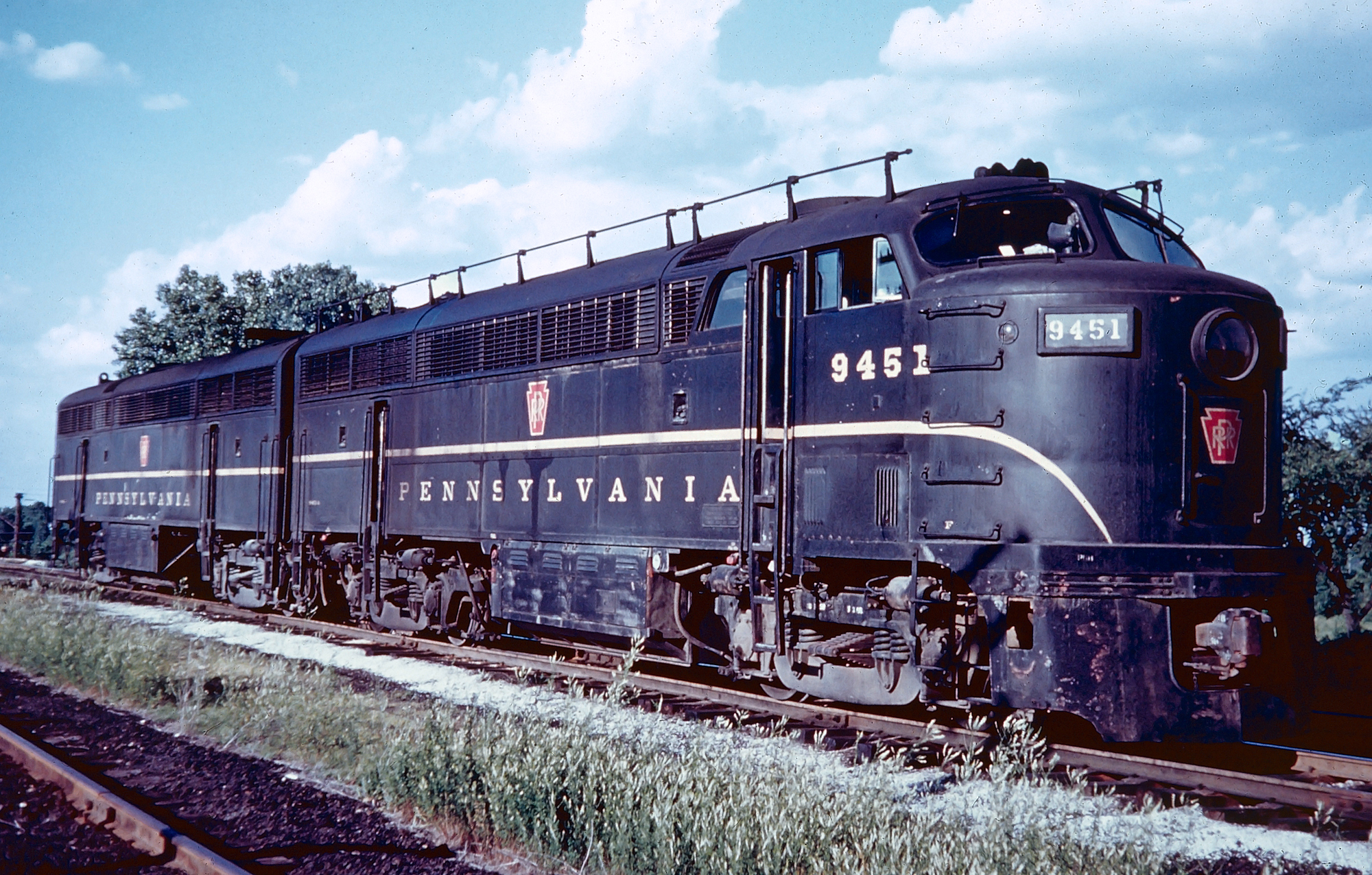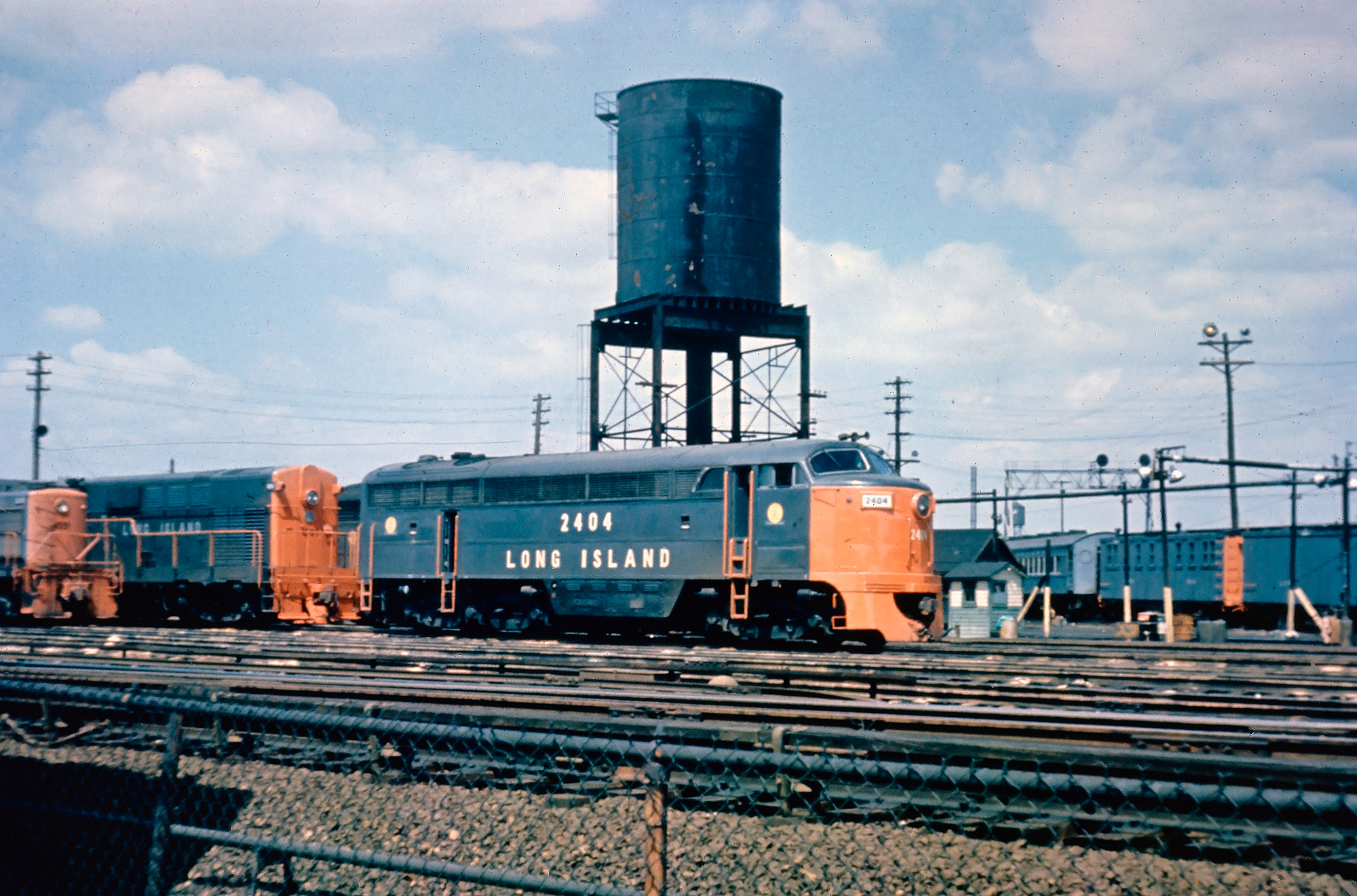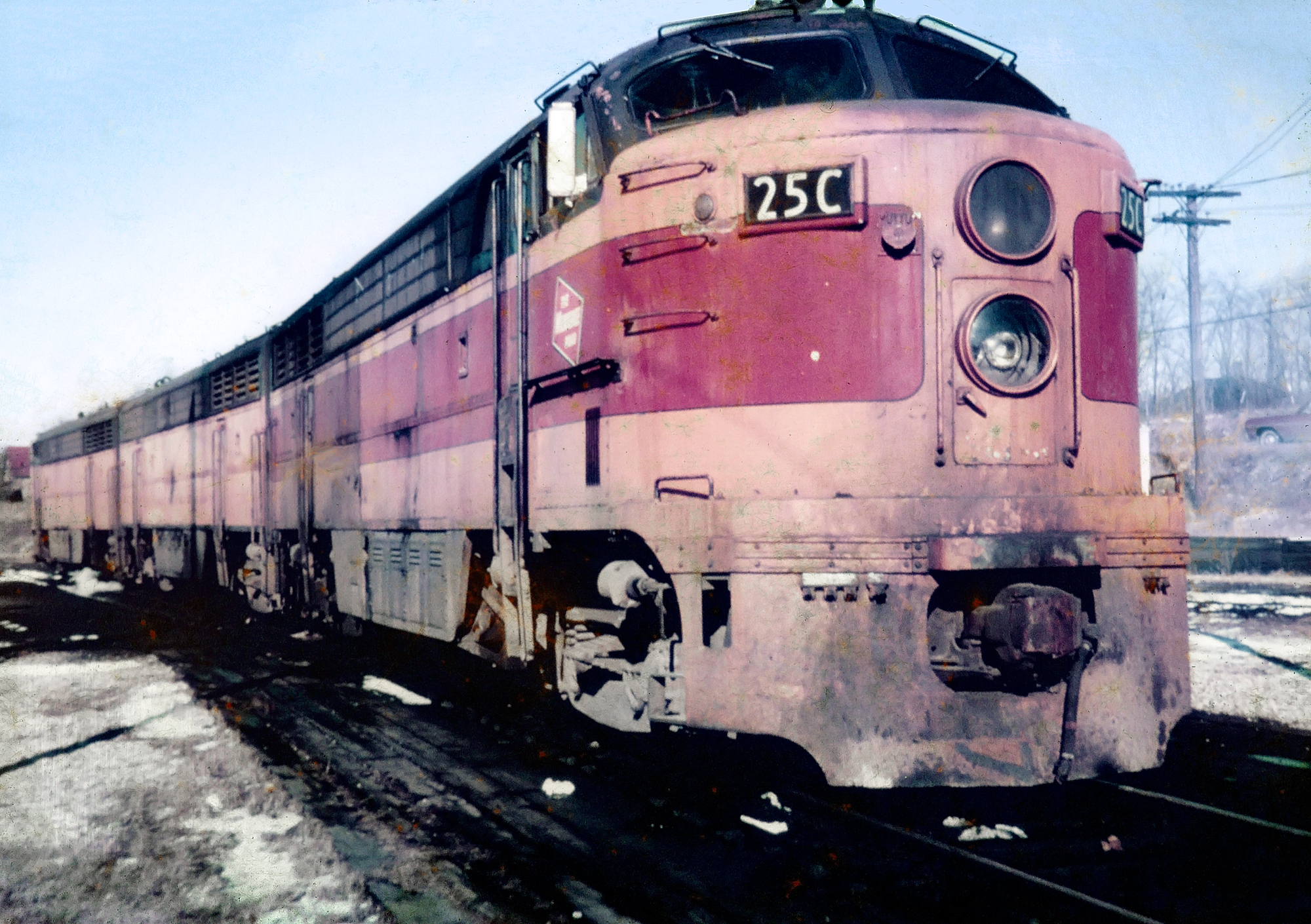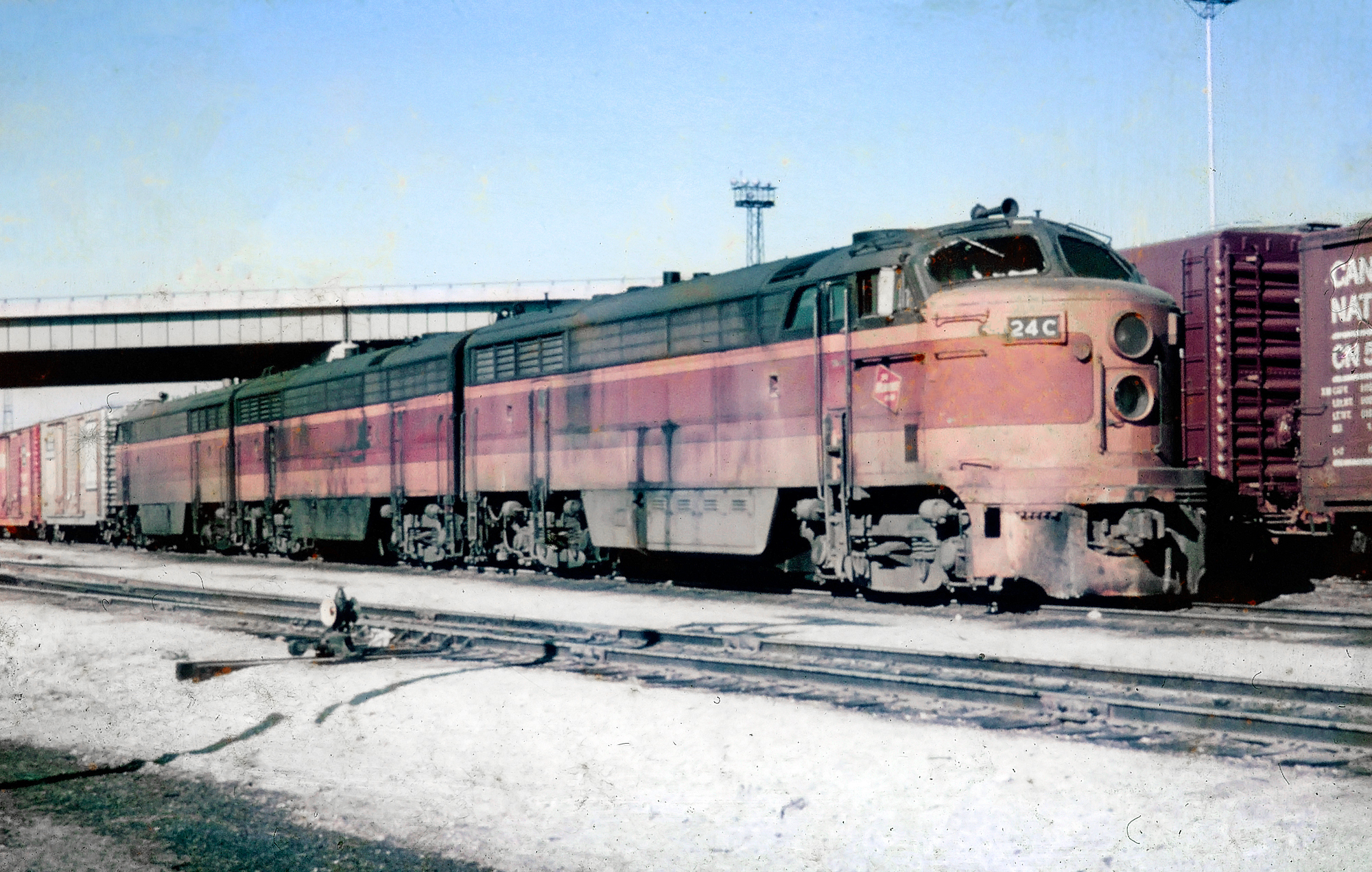FM "C-Liner" Locomotives: Specs, Roster, Photos
Last revised: December 27, 2024
By: Adam Burns
The C-Liners, officially cataloged as the builder's Consolidated Line included Fairbanks Morse cab models. Overall FM
built six different types of cab units during the 1950s that included the CPA16-4,
CPA16-5, CPA20-5, CPA24-5, CFA16-4, and CFA20-4.
The C-Liners replaced FM's earlier cab model the Erie-Built, which proved only marginally success at best. The updated version of FM's cab locomotives did not feature a carbody nearly as elegant as the former, which sported a European look.
It was offered for either passenger or freight (with four or six axles) service and intended to compete against Electro-Motive's (EMD) popular E and F series as well as Alco's FA and PA models.
Unfortunately, the C-Liners saw about the same level of success as the Erie-Builts and FM canceled the line after only a few years of production.
One system which tested most of FM's products was the Milwaukee Road. The company wound up with a fleet of twelve CFA16-4's and six CFB16-4's.
It was also quite fond of the Erie-Builts and owned many switchers and road-switchers. Ironically, despite FM's struggles in the industry the company is still in business today producing marine engines.
Photos
 A Pennsylvania "C-Liner" set (CFA16-4/CFB16-4) in Toledo, Ohio; June, 1962. Fred Byerly photo. American-Rails.com collection.
A Pennsylvania "C-Liner" set (CFA16-4/CFB16-4) in Toledo, Ohio; June, 1962. Fred Byerly photo. American-Rails.com collection.Overview
Fairbanks Morse entry into the cab locomotive market began with the Erie-Built model of 1945. This design was only intended for passenger service and had an appearance similar to the American Locomotive Company's (Alco) PA model with a long nose, and sweeping cab with a flush roofline.
While FM had hoped to be a strong competitor against EMD and Alco this was not to be as the company canceled production of the Erie-Built after cataloging it for just four years.
In 1950 they introduced a formal line of passenger and freight cab units known as the “Consolidated Line," more commonly referred to as C-Liners.
 Long Island Rail Road CPA24-5 #2404 lays over at Morris Park engine terminal in Richmond Hill, New York, circa 1955. Meyer Pearlman photo. American-Rails.com collection.
Long Island Rail Road CPA24-5 #2404 lays over at Morris Park engine terminal in Richmond Hill, New York, circa 1955. Meyer Pearlman photo. American-Rails.com collection.These models were available in three different horsepower variations of 1,600, 2,000, and 2,400 with the option of either four or five axles. The former was only offered in their freight models while the latter used an odd B-A1A wheel arrangement in passenger service.
The most lightly-powered C-Liner was the CFA16-4 introduced in early 1950; it produced 1,600 horsepower using a B-B truck arrangement and was designed freight service.
Designations
| C | Consolidation Line |
| F or P | Freight or Passenger Service |
| A or B | A or B Unit |
| 16, 20, 24 | Horsepower Rating (1600, 2000, 2400) |
| 4 | B-B Wheel Arrangement, 4 Powered Axles |
| 5 | B-A1A Wheel Arrangement: 2 Powered Lead Axles (B), Rear 3 Axles Include Center Axle Unpowered (A1A) |
Of all the C-Liners, the CFA16-4 sold the best outshopping 91 A and B units combined. However, the model sold much better to the Canadian Pacific and Canadian National (through FM's Canadian Locomotive Works) than it ever did to U.S. railroads as only the Milwaukee Road, Pennsylvania, and New York Central purchased examples.
Unfortunately, the rest of the line did not fare so well. The only other freight model, the CFA20-4, sold just 15 units. Fairbanks Morse's passenger models the CPA16-4, CPA16-5, CP20-5, and CP24-5 sold just 60 units combined. Of these, the five axle models (the CPA16-5, CP20-5, and CP24-5) are the most interesting.
Diagram
They featured a B-A1A setup whereby the front two axles were powered but the rear truck included three axles with a non-powered center axle (thus the term A1A).
The reason for this was that FM situated its steam generator (which powered on board amenities for passengers such as heating) in the rear of the locomotives and the area needed extra support.
 An A-B-A set of Milwaukee Road "C-Liners" (CFA16-4s and CFB16-4), with #25-C closest to the photographer, are tied down in Terre Haute, Indiana in February, 1967. Fred Byerly photo. American-Rails.com collection.
An A-B-A set of Milwaukee Road "C-Liners" (CFA16-4s and CFB16-4), with #25-C closest to the photographer, are tied down in Terre Haute, Indiana in February, 1967. Fred Byerly photo. American-Rails.com collection.While the FM C-Liners were unsuccessful from a sales standpoint it is not necessarily because Fairbanks Morse's models in general were unreliable (although part of their unattractiveness was due to the carbody design).
Reliability with FM's diesel locomotives has often been questioned but this issue was mostly due to the fact that FM's opposed-piston prime mover was simply too complicated to maintain and far different from the standard designs being offered by the other builders.
Data Sheet
| Entered Production | 9/1950 (Pennsylvania #9448A-9448B-9449A) |
| Years Produced | 9/1950 - 3/1952 |
| Fairbanks-Morse Class | CFA16-4/CFB16-4, CPA16-4/CPB16-4, CPA16-5/CPB16-5, CFA20-4/CFB20-4, CPA20-5, CPA24-5 |
| Engine | 38D8 1/8 Opposed-Piston (8 cylinders = 1,600 Horsepower: 10 cylinders = 2,000 Horsepower: 12 cylinders = 2,400 Horsepower) |
| Engine Builder | Fairbanks-Morse |
| Horsepower | 1600, 2000, 2400 |
| RPM | 300-850 |
| Length (Over Couplers) | 56' 6 1/2" |
| Height (Top Of Rail To Top Of Cab) | 14' 9 1/2" (Freight) or 14' 10 5/8" (Passenger) |
| Width | 10' 7" |
| Weight | See Table |
| Fuel Capacity | 1,200 Gallons |
| Air Compressor | WABCO-3CD |
| Air Brake Schedule | 24RL |
| Trucks | B-B or B-A1A |
| Truck Type | GSC Swing Bolster, Drop Side Equalizer |
| Truck Wheelbase | 9' 4" (B) and 15' 6" (A1A) |
| Wheel Size | 42" |
| Steam Generator (CP16-4) | 1,600-2,800 Lb/Hour: 1,000-1,150 Gallon Supply |
| Steam Generator (CP16-5/CP20-5) | 1,600-4,500 Lb/Hour: 1,600-1,800 Gallon Supply |
| Steam Generator (CP24-5) | 1,600-4,500 Lb/Hour: 1,500 Gallon Supply |
| Traction Motors | 370DE (4), Westinghouse |
| Traction Generator (1,600 hp) | 497B, Westinghouse |
| Traction Generator (2,000 and 2,400 hp) | 498A, Westinghouse |
| Auxiliary Generator | YG54A, Westinghouse |
| MU (Multiple-Unit) | Yes |
| Dynamic Brakes | Optional |
| Gear Ratio | See Table |
| Tractive Effort | See Table |
| Top Speed | See Table |
For instance, in regards to the Train Master, it has been noted by John Kirkland in his book The Diesel Builders Volume 1 that the Train Masters performed admirably for more than 20 years on the Southern Pacific due to a maintenance team that understood the model.
The locomotives took a daily beating hauling freight trains, and later in commuter service, without series mechanical problems.
Weight Table (In Pounds)
| CF16-4 | CF20-4 | CF24-4 | CP16-4 | CP16-5 | CP20-5 | CP24-5 | |
|---|---|---|---|---|---|---|---|
| A Unit | 249,500 | 258,000 | 264,000 | 261,500 | 286,000 | 294,500 | 300,500 |
| B Unit | 246,000 | 254,500 | 260,500 | 258,000 | 282,000 | 290,500 | 296,500 |
Variants of FM's Consolidated Line were essentially the same locomotive and differed only in horsepower rating and truck arrangement.
Gearing Options
| Gear Ratio | Maximum Speed | Continuous Tractive Effort (Lbs) | Continuous TE Rating Speed |
|---|---|---|---|
| 68:15 | 65 | 52,500 | 9.2 mph (1,600 hp): 11.9 (2,000 hp): 14.2 (2,400 hp) |
| 63:15 | 70 | 48,600 | 9.9 mph (1,600 hp): 12.8 (2,000 hp): 15.3 (2,400 hp) |
| 62:17 | 80 | 42,200 | 11.4 mph (1,600 hp): 14.7 (2,000 hp): 17.6 (2,400 hp) |
| 60:19 | 90 | 36,500 | 13.2 mph (1,600 hp): 17.0 (2,000 hp): 20.4 (2,400 hp) |
| 58:21 | 100 | 32,000 | 15.1 mph (1,600 hp): 19.5 (2,000 hp): 23.3 (2,400 hp) |
| 57:22 | 110 | 30,000 | 16.1 mph (1,600 hp): 20.8 (2,000 hp): 24.8 (2,400 hp) |
As such, only a single data sheet will be included with notes highlighting each model's differences (if necessary). The C-Line began with the CFA16-4/CFB16-4 (first completed in September, 1950) and ended with the CPA24-5/CPB24-5 (final completed in March, 1952).
Production Rosters
CFA16-4/CFB16-4 (FM)
Total Built = 54
| Owner | Road Number | Construction Number | Contract Number | Completion Date | Quantity |
|---|---|---|---|---|---|
| Pennsylvania | 9448A-9453A | 16L339-16L344 | LD88 | 9/1950 | 6 |
| Pennsylvania | 9454A-9455A | 16L345-16L346 | LD88 | 10/1950 | 2 |
| Pennsylvania | 9492A-9497A | 16L347-16L352 | LD88 | 10/1950 | 6 |
| Pennsylvania | 9498A-9499A | 16L353-16L354 | LD88 | 11/1950 | 2 |
| Pennsylvania | 9448B (B) | 16L355 | LD88 | 9/1950 | 1 |
| Pennsylvania | 9450B (B) | 16L356 | LD88 | 9/1950 | 1 |
| Pennsylvania | 9452B (B) | 16L357 | LD88 | 9/1950 | 1 |
| Pennsylvania | 9454B (B) | 16L358 | LD88 | 10/1950 | 1 |
| Pennsylvania | 9492B (B) | 16L359 | LD88 | 10/1950 | 1 |
| Pennsylvania | 9494B (B) | 16L360 | LD88 | 10/1950 | 1 |
| Pennsylvania | 9496B (B) | 16L361 | LD88 | 10/1950 | 1 |
| Pennsylvania | 9498B (B) | 16L362 | LD88 | 11/1950 | 1 |
| Milwaukee Road | 23A, 23C | 16L479-16L480 | LD113 | 7/1951 | 2 |
| Milwaukee Road | 24A, 24C | 16L481-16L482 | LD113 | 8/1951 | 2 |
| Milwaukee Road | 25A, 25C | 16L483-16L484 | LD113 | 8/1951 | 2 |
| Milwaukee Road | 26A, 26C | 16L485-16L486 | LD113 | 8/1951 | 2 |
| Milwaukee Road | 27A, 27C | 16L487-16L488 | LD113 | 9/1951 | 2 |
| Milwaukee Road | 28A, 28C | 16L489-16L490 | LD113 | 9/1951 | 2 |
| Milwaukee Road | 23B (B) | 16L491 | LD113 | 7/1951 | 1 |
| Milwaukee Road | 24B-26B (B) | 16L492-16L494 | LD113 | 8/1951 | 3 |
| Milwaukee Road | 27B-28B (B) | 16L495-16L496 | LD113 | 9/1951 | 2 |
| New York Central | 6600-6607 | 16L541-16L548 | LD126 | 2/1952 | 8 |
| New York Central | 6900-6902 (B) | 16L549-16L551 | LD126 | 2/1952 | 3 |
| New York Central | 6903 (B) | 16L560 | LD126 | 2/1952 | 1 |
CFA16-4/CFB16-4 (Canadian Locomotive Company)
Total Built = 35
| Owner | Road Number | Construction Number | Completion Date | Quantity |
|---|---|---|---|---|
| Canadian National | 8700, 8702 | 2648-2649 | 1/1952 | 2 |
| Canadian National | 8704 | 2668 | 5/1952 | 1 |
| Canadian National | 8701, 8703, 8705 (B) | 2669-2671 | 5/1952 | 3 |
| Canadian National | 8706-8722 (Evens) | 2696-2704 | 12/1952 | 9 |
| Canadian National | 8724-8730 (Evens) | 2705-2708 | 1/1953 | 4 |
| Canadian National | 8732-8740 (Evens) | 2709-2713 | 3/1953 | 5 |
| Canadian National | 8742, 8744 | 2714-2715 | 3/1953 | 2 |
| Canadian Pacific | 4076-4078 | 2716-2718 | 4/1953 | 3 |
| Canadian Pacific | 4079-4081 | 2719-2721 | 5/1953 | 3 |
| Canadian Pacific | 4455-4457 (B) | 2722-2724 | 4/1953 | 3 |
| Canadian Pacific | 4458 (B) | 2725 | 5/1953 | 1 |
CPA16-4/CPB16-4 (Canadian Locomotive Company)
Total Built = 18
| Owner | Road Number | Construction Number | Completion Date | Quantity |
|---|---|---|---|---|
| Canadian Pacific | 7005-7006 | 2646-2647 | 5/1951 | 2 |
| Canadian Pacific | 4052 | 2680 | 6/1952 | 1 |
| Canadian Pacific | 4053 | 2681 | 7/1952 | 1 |
| Canadian Pacific | 4054 | 2682 | 8/1952 | 1 |
| Canadian Pacific | 4055-4057 | 2683-2685 | 9/1952 | 3 |
| Canadian Pacific | 4449 (B) | 2686 | 6/1952 | 1 |
| Canadian Pacific | 4450 (B) | 2687 | 7/1952 | 1 |
| Canadian Pacific | 4451 (B) | 2688 | 8/1952 | 1 |
| Canadian Pacific | 4452-4454 (B) | 2689-2691 | 9/1952 | 3 |
| Canadian Pacific | 4104 | 2726 | 4/1954 | 1 |
| Canadian Pacific | 4105 | 2727 | 5/1954 | 1 |
| Canadian Pacific | 4471 (B) | 2728 | 4/1954 | 1 |
| Canadian Pacific | 4472 (B) | 2729 | 5/1954 | 1 |
CPA16-5/CPB16-5 (Canadian Locomotive Company)
Total Built = 12
| Owner | Road Number | Construction Number | Completion Date | Quantity |
|---|---|---|---|---|
| Canadian National | 6700-6701 | 2850-2851 | 12/1954 | 2 |
| Canadian National | 6702-6703 | 2852-2853 | 1/1955 | 2 |
| Canadian National | 6704-6705 | 2854-2855 | 2/1955 | 2 |
| Canadian National | 6800-6801 (B) | 2856-2857 | 12/1954 | 2 |
| Canadian National | 6802-6803 (B) | 2858-2859 | 1/1955 | 2 |
| Canadian National | 6804-6805 (B) | 2860-2861 | 2/1955 | 2 |
CFA20-4/CFB20-4 (FM)
Total Built = 15
| Owner | Road Number | Construction Number | Contract Number | Completion Date | Quantity |
|---|---|---|---|---|---|
| New York Central | 5102 (B) | 21L270 | LD72 | 5/1950 | 1 |
| New York Central | 5103 (B) | 21L271 | LD72 | 6/1950 | 1 |
| New York Central | 5104 (B) | 21L272 | LD72 | 7/1950 | 1 |
| New York Central | 5006-5009 | 21L288-21L291 | LD72 | 3/1950 | 4 |
| New York Central | 5010-5013 | 21L292-21L295 | LD72 | 4/1950 | 4 |
| New York Central | 5014-5015 | 21L296-21L297 | LD72 | 5/1950 | 2 |
| New York Central | 5016 | 21L298 | LD72 | 6/1950 | 1 |
| New York Central | 5017 | 21L299 | LD72 | 7/1950 | 1 |
CPA20-5 (FM)
Total Built = 8
| Owner | Road Number | Construction Number | Contract Number | Completion Date | Quantity |
|---|---|---|---|---|---|
| Long Island Rail Road | 2001-2004 | 21L331-21L334 | LD86 | 6/1950 | 4 |
| Long Island Rail Road | 2005-2006 | 21L335-21L336 | LD86 | 7/1950 | 2 |
| Long Island Rail Road | 2007 | 21L337 | LD87 | 7/1950 | 1 |
| Long Island Rail Road | 2008 | 21L338 | LD87 | 8/1950 | 1 |
CPA24-5 (FM)
Total Built = 22
| Owner | Road Number | Construction Number | Contract Number | Completion Date | Quantity |
|---|---|---|---|---|---|
| Fairbanks-Morse | 4801-4802* | 21L273-21L274 | LD123 | 4/1951 | 2 |
| Long Island Rail Road | 2401-2404 | 21L497-21L500 | LD114 | 9/1951 | 4 |
| New Haven | 792-799 | 21L533-21L540 | LD124 | 1/1952 | 8 |
| New York Central | 4500-4507 | 21L552-21L559 | LD125 | 3/1952 | 8 |
* Became New Haven #790-791.
Sources
- Kirkland, John F. Diesel Builders, The: Fairbanks-Morse And Lima-Hamilton. Glendale: Interurban Press, 1985.
- Pinkepank, Jerry A. Diesel Spotter's Guide. Milwaukee: Kalmbach Publishing Company, 1967.
- Schafer, Mike. Vintage Diesel Locomotives. Osceola: MBI Publishing, 1998.
 A Milwaukee Road CFA16-4/CFB16-4 "C-Liner" set, led by #24-C, is seen here arriving at the "A" Yard along the east end of the Bensenville, Illinois terminal in February, 1966. Typically known as the "Southeastern" train, this freight served the line to Terra Haute, Indiana. Fred Byerly photo. American-Rails.com collection.
A Milwaukee Road CFA16-4/CFB16-4 "C-Liner" set, led by #24-C, is seen here arriving at the "A" Yard along the east end of the Bensenville, Illinois terminal in February, 1966. Typically known as the "Southeastern" train, this freight served the line to Terra Haute, Indiana. Fred Byerly photo. American-Rails.com collection.In the end, however, railroads and mechanical departments found the opposed-piston not to their liking when builders like Electro-Motive offered wonderfully reliable and rugged designs with standard prime movers.
All of the FM C-Liners had internal components such as traction motors, generators, and air equipment outsourced to Westinghouse Electric.
Overall, virtually every model offered tractive efforts ranging from 65,000-70,000 pounds starting to 32,000 pounds continuous. Additionally, all C-Liners offered dynamic braking, something Fairbanks Morse did not include with many of its early diesel models.
Today, at least three C-Liners are known to be preserved all of which are located in Canada (it is said one C-Liner still owned by Canadian Pacific remains stored but operational).
Contents
Recent Articles
-
A South Carolina Christmas Train Ride In Winnsboro!
Oct 29, 25 11:41 PM
Tucked into the piney countryside just north of Columbia, the South Carolina Railroad Museum is where the state’s railroading past comes alive on steel rails. -
A Pennsylvania Christmas Train Ride in Boyertown!
Oct 29, 25 11:18 PM
Among Colebrookdale's many themed excursions, the seasonal Christmas trains have become a cherished tradition for families, railfans, and holiday romantics alike, blending Old World elegance with smal… -
An Oregon Christmas Train Ride On The Candy Cane Express!
Oct 29, 25 11:13 PM
If you love the timeless romance of vintage trains and the raw beauty of the Pacific Northwest, the Oregon Coast Scenic Railroad delivers both in generous measure. B




